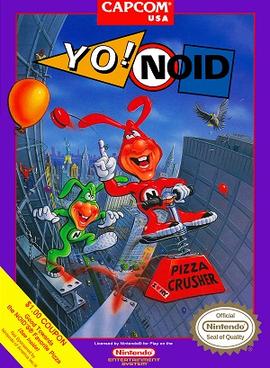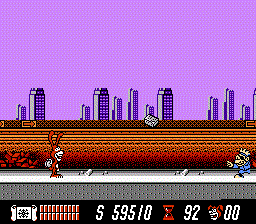I know this is a reskin of another game, but I actually tried playing a fan-translated version of Wagyan Land years ago, before I knew of Steamgifts–let alone BLAEO. I’d made it to the first boss, where you’re supposed to pick an image whose word starts with the same letter that your opponent’s word ended with, and since that letter was S, I chose the tile with a sock on it since I didn’t see anything that began with a K…except the word ended up being “socks,” which let the boss choose the sun card. I didn’t lose outright, but I didn’t see anything that began with an N, either (bear in mind around half the cards were gone at this point), so I just stopped playing and never got around to giving it another chance. Honestly, part of the reason I decided to play this game is because I remembered seeing a couple YouTube videos on it, so I knew that its tile-selection minigame was different.

Platformer. Left/right move, A jumps, and B attacks (but since your weapon is a yo-yo, you have to wait for it to come back before you can attack again, which is annoying when enemies take multiple hits to kill). You can also spend MP to use special abilities you can find in the levels, but to do that, you have to push down and B simultaneously. I had to look up the manual to learn that, and even when you know what to do, it can take a bit to get the timing right. Also, both the potion and the 8-way arrows both do a screen-clearing attack; it’s just that the potion costs less MP.
Something you’ll notice early on is that, although stages aren’t too long (only a minute or two), they don’t have checkpoints and you die in one hit. Why does the game have lives, then, you may ask? Because you only have 3 continues, after which you have to start the whole game over from the beginning (you can earn more continues, but to get enough points for that, you have to beat, like, three levels in a row without getting game over). I know it was a trend for games back then to do this (as well as certain modern hack “retro inspired” games), but there’s plenty of evidence to show that–even back then–devs knew this wasn’t good game design. There’s a cheat code in the NES Super Mario Bros that lets you continue from the world you got game over on (like how the All-Stars version works normally), and even Capcom themselves made a game three years before this game that has infinite continues by default, and yet it was fairly well-received and financially successful. You might’ve even heard of it: it’s called Mega Man! That said, if Wikipedia is to be believed, this game was merely published by Capcom and developed by another company that didn’t get credited in-game.
Suffice to say, I used savestates to beat the game.
If I had to guess why they chose to limit continues despite infinite-continue games having been tried-and-true by this point in time, I’d say it’s because the level design is simple. It’s not bland–I’ve played enough bad games to know what true blandness is–but it definitely pales in comparison to its contemporaries (like Super Mario Bros. 3 and Mega Man 2). The difficulty curve also isn’t consistent; I found level 12 (the one with the conveyor belts) to be one of the easiest ones despite it being just a couple levels before the end. Can’t have customers beating the game in a single rental period, can we?
Also, somewhat unexpected for a NES game (at least from my perspective) is that there are gimmicks that only get used once or twice in the whole game. The first level has every platform going up and down, so you have to be careful not to be on one that’s about to sink into the death water…but that’s the only level where this happens. The second level is the only one with ice physics and the only one with platforms that break if you stand on them too long. Level 3 is the only one where you’re on a skateboard and you kill enemies by jumping on them since your default yo-yo attack is disabled here (in every other level, jumping on enemies gets you killed). There’s a whole TWO levels where you’re flying in midair and have to tap jump to stay airborne as you progress. There are even multiple different enemy types that only show up in a single level. I would’ve assumed that NES devs would have been more conscientious about using up storage space, but then again, they managed to get 14 levels out of it, even if they did end up being rather simple levels.
Despite the simplicity of the level design, some cheap hits are snuck in there as well. In the first level, there’s a fish enemy that’ll jump up from below the screen, not going too high the first time–but the second time, it jumps higher, faster, and a few units to the left of where it first jumped–which often ends up being right where you’re standing, waiting for the next platform to come up out of the death water. Level 7 (the circus) has what looks and acts like the level’s previously-introduced up/down-moving platforms, except when you get within a unit or two of it, there’s a split-second smoke-puff animation before it turns into a horizontally-moving enemy, moving towards you. The worst is in level 10, where it looks like you can run under the bricks an enemy throws, except…

Honestly, this one’s crazy enough that it might be my emulator at fault, but personally, I’d find it even more wild that NES emulation still has problems after all this time.
Then there are the bosses, which–as alluded to previously–eschew the platformer mechanics in favor of a tile-selection minigame. The computer randomly picks a tile on its side, and then you have to pick a tile on your side with a larger number–if you have one. The difference between the numbers determines how many points you or the enemy gets, with you needing to get a set number of points to win. Thing is, you have more than just basic number tiles: there are tiles with roman numerals on them, and tiles with pictures on them. What do they do? Well, the game doesn’t make it clear, so I checked the manual, and…it doesn’t say. For crying out loud, the whole point of manuals is to explain stuff like this! Instead, the manual describes the game like they’re still trying to sell it to you, and the boss fights barely get a sentence alluding to their existence. So yeah, I had to do trial and error to figure out that the symbol tiles force the boss to discard its selected tile and the roman numeral cards double or triple the number on whichever card you pick next. Also, each round has its own time limit, so you only have a few seconds to choose one of the roman numeral cards to figure out what it does, then realize it doesn’t do anything by itself and that you have to pick another card, because if you run out of time, you don’t just lose the round–you lose the whole battle and a life and have to play the level again.
Still, these minigames have potential, but what holds them back is that they aren’t separated enough from the rest of the game. See, those roman numeral cards and symbol cards? You find those within the platformer levels, and sometimes the only way to reveal them is to attack a seemingly-random, innocuous spot in the level to reveal them (you eventually learn to just toss your yo-yo constantly in hopes of finding them by accident). I’m also pretty sure that if you don’t find (enough of) them, the boss battles become impossible to win no matter what your strategy is, but thankfully, I never ended up in that situation (all the bosses after the first one ended up being really easy). Oh jeez, is that the real reason the game doesn’t have infinite continues? Because you can screw yourself over by losing all your lives too close to a boss? Too cruel.
Overall, I could’ve forgiven the simple level design and even a few of the cheap hits, but having limited continues–whatever the reason may be–is what puts this into not-recommended territory for me.